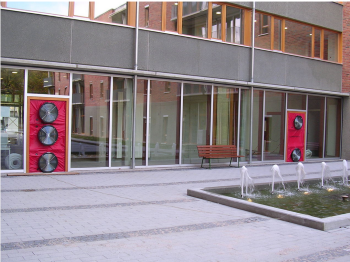As Building Enclosure Commissioning starts to take root in Canada, we’re doing our part to offer field air tightness testing services. Having tested 2 LEED Platinum buildings and one LEED Gold building, we expect growth in the demand for large building testing. To meet the demand, we’ve recently invested heavily in 12 blower door fans with the intention of testing quality buildings in the construction phase.
So what size of building can we test with that kind of gear you ask? The answer is; it depends primarily on how much your building leaks and secondarily on the physical size!
Using the ASHRAE 90.1 Guidelines for air leakage which categories building into Air tight, Average and Very Leaky, this is what BlueGreen Group has the equipment to do:
| ASHRAE 90.1 Building Leakage Rate |
Upper limit (CFM75/Ft2) |
Maximum Surface Area (m2) |
| Air Tight |
0.1 |
55,000 |
| Average |
0.3 |
18,000 |
| Really Leaky |
0.6 |
9,000 |
Remember, that a building’s surface area includes the exterior walls, the floor (or slab foot-print) and the ceilings – it even includes cantilevered floors! To put this into local perspective, the LEED Platinum Brick Works building in the Don Valley ravine has a surface area is less than 5000 m2 and a conditioned volume of about 18,000m3.
The video below allows you to final use your French immersion skills and shows a new 39 story office tower or IGH (Immeuble de Grande Hauteur) is being tested in Lyon, France. With a total of 10 Retrotec fans – four on the 2nd floor, and two on each of the 9th, 21st and 33nd floors, this air tight building didn’t take many fans. The building owners targeted air leakage of 1m3/(hr·m2) and the results beat the target handily with a mere 0.45m3/(hr·m2). The total building volume was 180,301m3.
The video below shows a massive Amazon distribution centre being tested in Poland. With a total volume of 1,142,000m3, this is probably the largest test completed on a building to date. A total of 24 Retrotec fans were installed.
All 3 videos on this page give insights on the preparation work that goes into testing buildings. The following does a good job to describe the process for testing.

